Barb fish are some of the oldest additions to the aquarium hobby. They have been tank bred for dozens of generations as well. Making them resistant to disease and accepting of a wide range of water conditions.
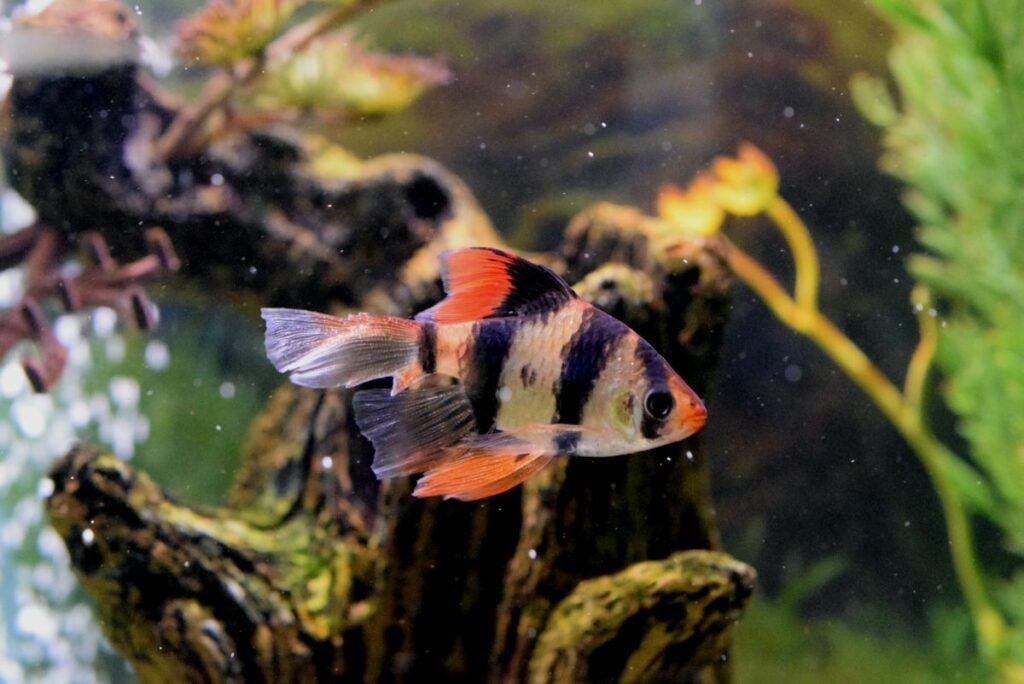
Barbs eat anything offered and most are brightly colored. Is there a type of barb fish out there that would be perfect for your community aquarium?
What are Barb Fish?
Barb aquarium fish are members of the family Cyprinidae. They get their name from the Latin word for “beard,” pointing to the whiskers or barbels that these fish have.
The Cyprinid family includes several aquarium favorites besides barbs: goldfish, koi, and rasboras are also members of this large group. Loaches are also close relations.
Barb fish are midwater swimmers that tend to be schooling or shoaling fish. They are found throughout the Old World (Africa, Europe, and Asia). That said, the majority of aquarium favorites are from South and Southeast Asia.
Barbs come in a wide range of sizes, with the majority growing 2 to 4 inches in length. Coupled with how active they are, barbs are medium sized fish suitable for 20 to 30 gallon fish tanks. This list does have a couple of species that do well in smaller 10 gallon tanks, however.
10 Types of Barb Fish
There are dozens of barbs fish that you might encounter at a pet store, from time to time. But these are the 10 species that show up the most often.
Tiger Barb
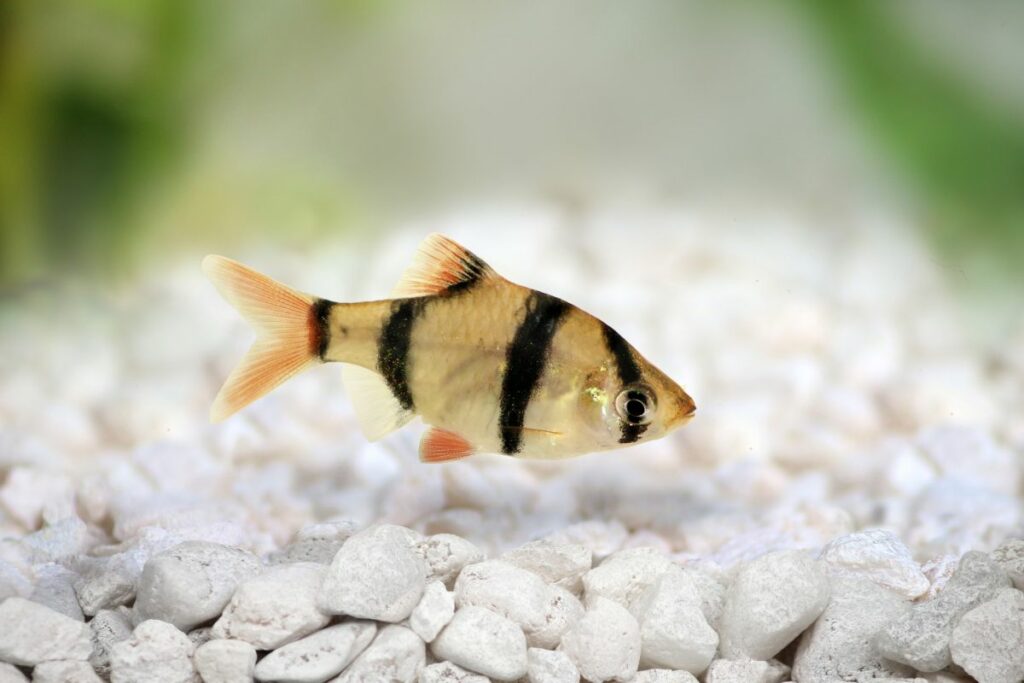
Of all the barb fish species available, the tiger barb is the most popular. And for several good reasons.
They come in several attractive color morphs, including the green, albino, and cherry red barb. But even the wild-type color is interesting, with black and cream stripes and red fins.
Males have bright red noses and fin tips while females are a little less colorful. Tiger barbs are infamous for being fin nippers. They will target betta fish, angelfish, and other slow moving species with long fins.
Choose tank mates with care. Keeping tiger barbs in groups of 6 fish or more also helps contain their aggression since they will pick at each other instead.
- Scientific Name: Puntigrus tetrazona
- Origin: Malaysia & Indonesia
- Length: 3 inches
- Temperament: Semi-aggressive
Rosy Barb
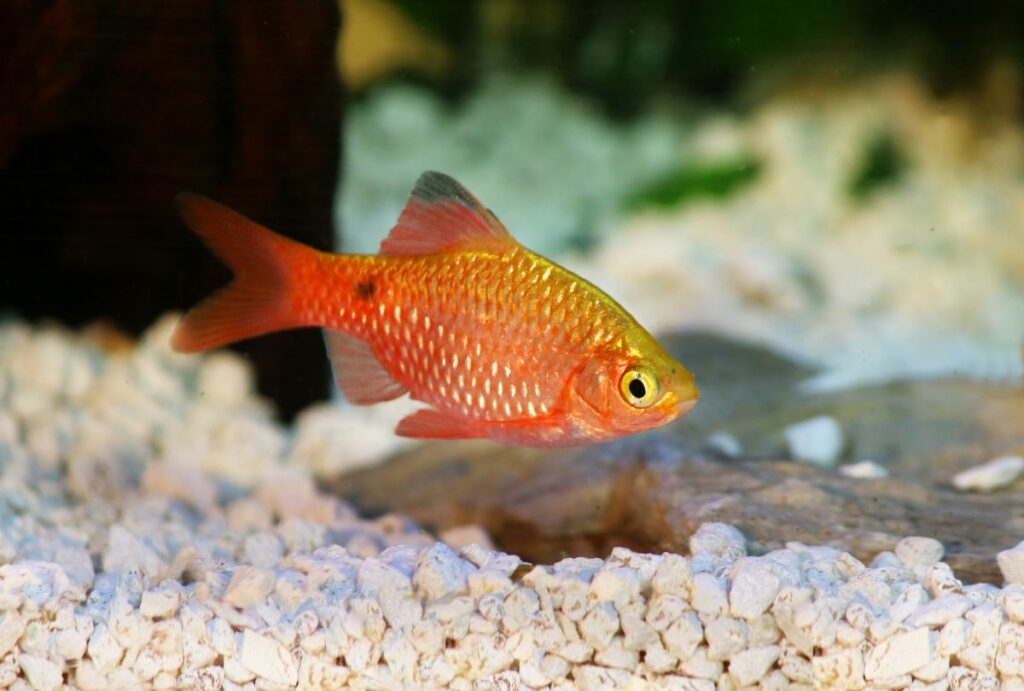
The pink blush and iridescent scales of rosy barbs are hard not to appreciate. As is the size of these barb fishes; they grow up to 6 inches long, making 30 to 40 gallon tanks the minimum for an adult.
Rosy barb care is straightforward, but one detail that aquarists don’t often realize is that these fish prefer cooler conditions. Temperatures of 65-73℉ are what they prefer. In fact, rosy barbs are excellent choices for room temperature coldwater aquariums.
They are identical in care to a small goldfish. Plus they don’t have the fin-nipping tendencies that tiger barbs do.
- Scientific Name: Pethia conchonius
- Origin: South Asia
- Length: 4 to 6 inches
- Temperament: Peaceful
Tinfoil Barb
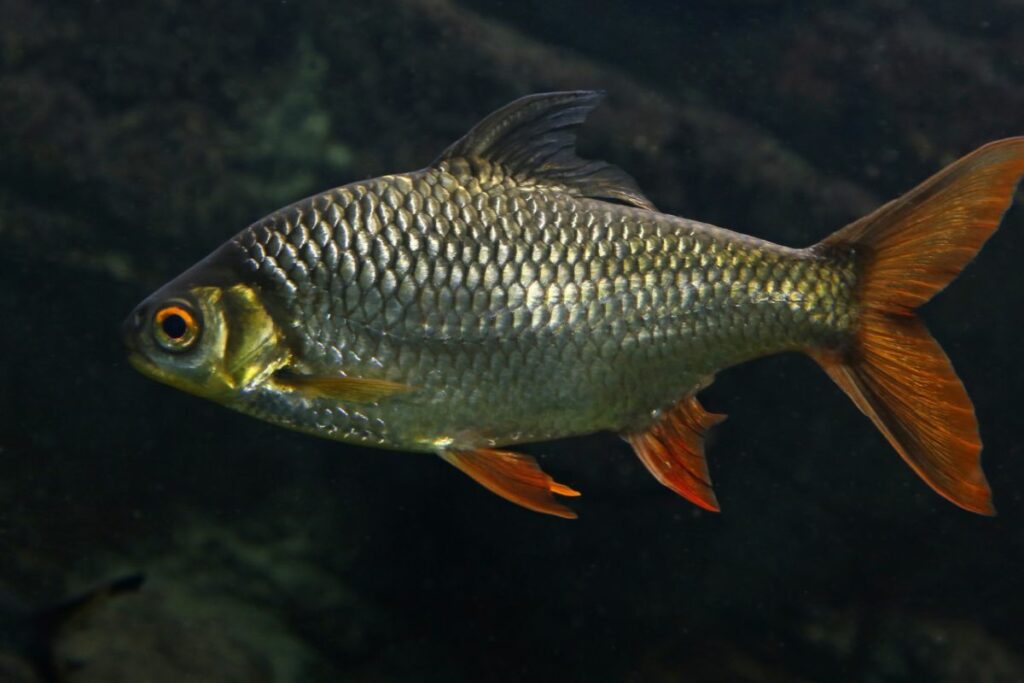
Tinfoil barbs get their name from their metallic silver scales. They are an unusual barb fish species as they grow much larger than their relatives.
Tinfoil barbs reach up to 14 inches long and will live for 10 to 15 years. 5 years is a long lifespan for any of the smaller freshwater barbs.
Small barbs tend to be omnivorous as well, eating equal amounts of plant and animal matter. But tinfoil barbs are herbivores, eating soft aquatic plants with the occasional worm or insect larvae.
Tinfoil barbs are schooling, like other barbs. And they are very skittish and prone to jumping or slamming into decorations if you make sudden moves around their tank. Which makes keeping them difficult at times.
They need very large aquariums, but make excellent dither fish for large, predatory species like arowanas, peacock bass, and freshwater stingrays.
- Scientific Name: Barbonymus schwanenfeldii
- Origin: Southeast Asia
- Length: 14 inches
- Temperament: Peaceful
Cherry Barb
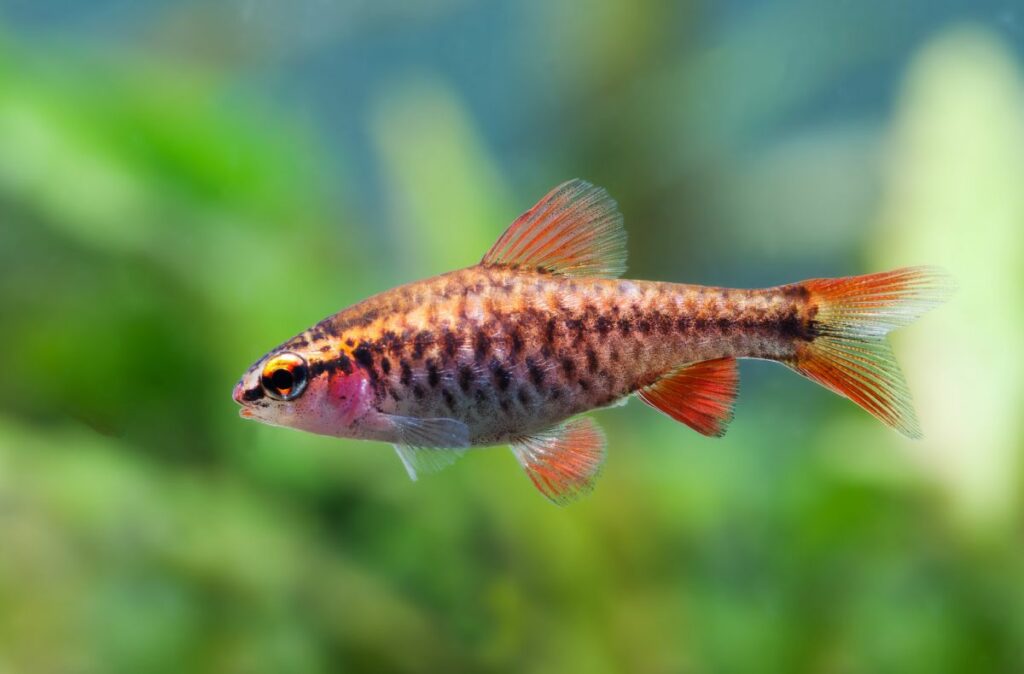
The cherry barb is the best barbs fish for smaller aquariums. Adult females are full grown at 2 inches, while males top out at 1.5 inches. Both sexes have a checkerboard pattern but the males take on a bright red glow. That grows even more intense when competing for females.
Cherry barbs are peaceful and shoal together rather than school. Meaning they live in loose groups but don’t swim in a pack. They are very peaceful and don’t nip fins or harass their tank mates.
Choose community fish with a similar disposition, like dwarf gouramis, tetra fish, upside down catfish, and mollies as tank mates.
- Scientific Name: Puntius titteya
- Origin: Sri Lanka
- Length: 1.5 to 2 inches
- Temperament: Peaceful
Gold Barb
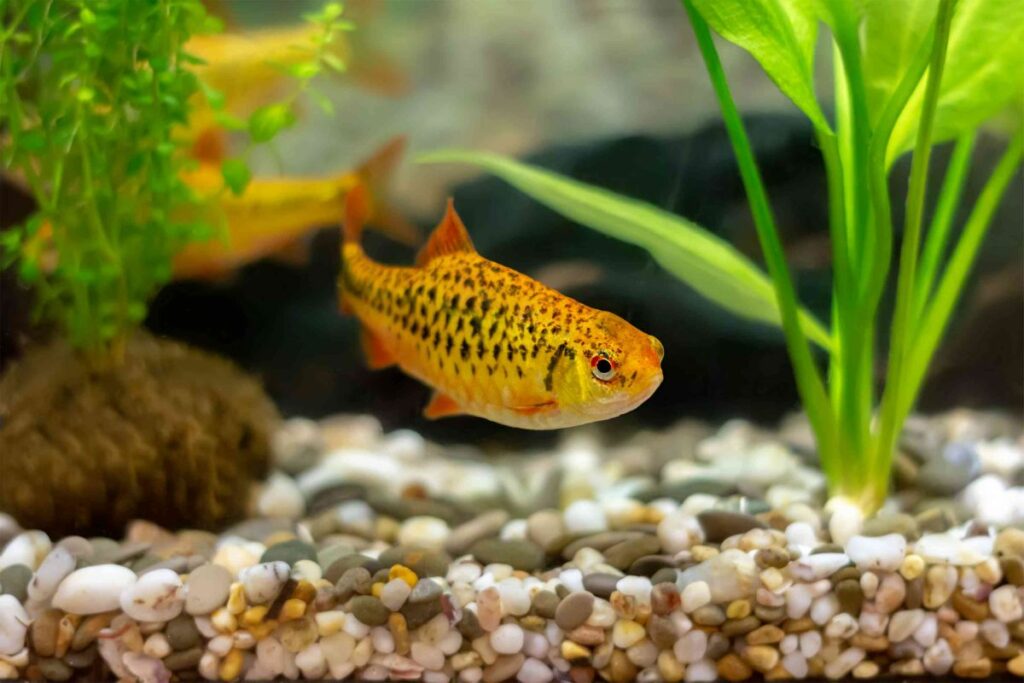
Gold barbs are natives of China and Vietnam, found only in the Red River basin. Goldfish were domesticated in this region as well.
And like their close relatives, gold barbs were bred to show this vibrant hue. Wild gold barbs are dark green color; still attractive but rare to see in the aquarium trade.
These are one of the easier types of barbs to tell males from females. The females are a duller shade of gold and a bit plumper. Males are slimmer and brighter in color.
Gold barbs spawn with ease in captivity. Plus they are small enough for a group to be comfortable in a 20-30 gallon aquarium.
- Scientific Name: Barbodes semifasciolatus
- Origin: Red River basin
- Length: 2 to 3 inches
- Temperament: Peaceful
Denison Barb
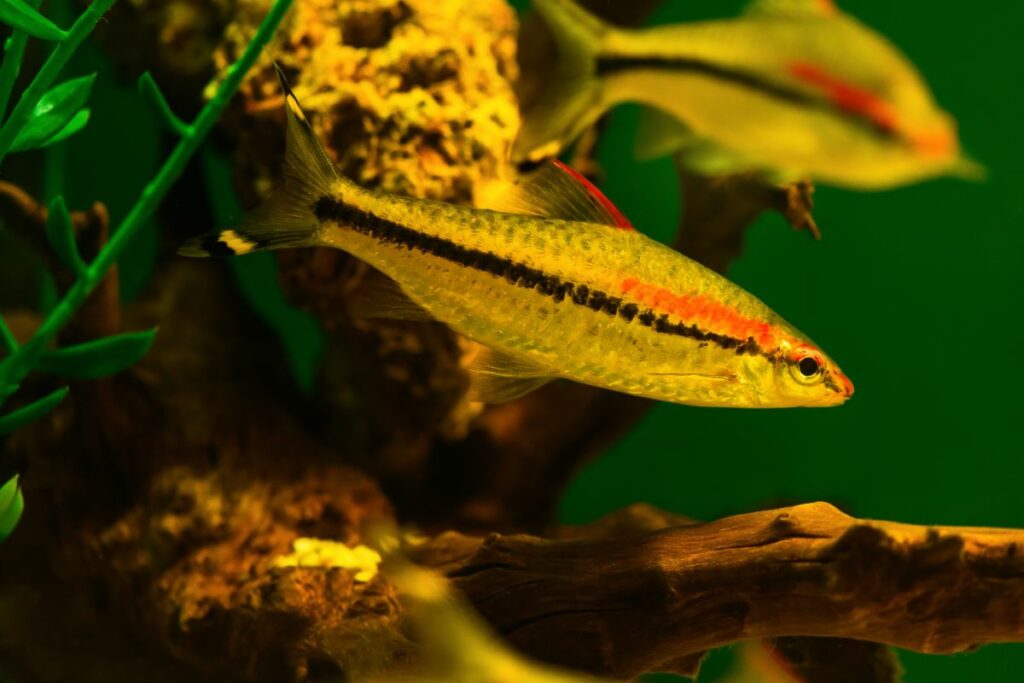
Denison barbs are also known as roseline sharks thanks to their bright red and yellow stripes. They reach up to 6 inches long, are schooling fish, and are very active. The minimum tank size for a school is 55 gallons, with 75 gallons being better.
They are also an unfortunate tale as their popularity since the year 2000 has caused them to become an endangered species in their homeland of India. Captive breeding efforts have stepped up in recent years, hopefully preventing their extinction.
Denison barbs need water current to fight against, making a powerhead an essential addition. They also need well aerated water rich in oxygen. Otherwise they are beautiful additions to communities of medium-sized fish.
- Scientific Name: Sahyadria denisonii
- Origin: Western Ghats, India
- Length: Up to 6 inches
- Temperament: Peaceful
Black Ruby Barb
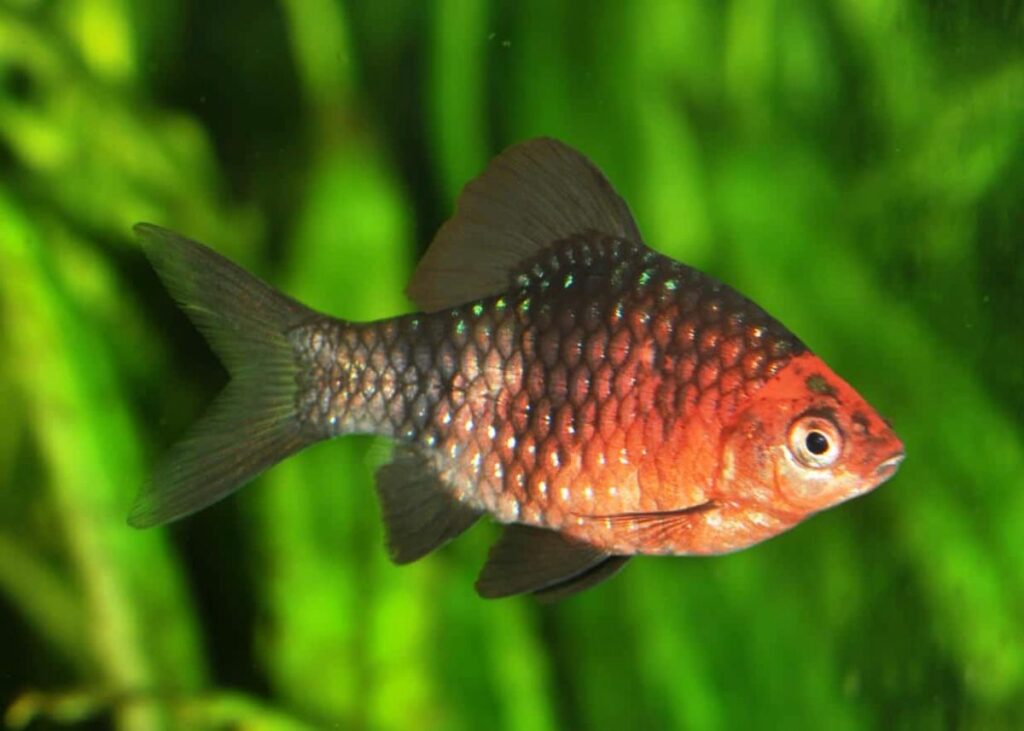
When you see new arrivals at your local pet store, it may not seem obvious why these fish are called black ruby barbs. They will often look washed out in color, with gray and cream stripes.
But once you take a few home and get them settled in, the gray becomes purple. And the males take on dark purple and red tones with star-like iridescence. Colors that intensify even more when looking to spawn.
Black ruby barb fish are Sri Lankan natives like cherry barbs. Both are shy barbs that prefer small, peaceful tank mates in well planted aquariums. While omnivorous, black ruby barbs won’t harm live plants. Just be sure to give them vegetable or spirulina-fortified flakes on occasion.
- Scientific Name: Pethia nigrofasciata
- Origin: Sri Lanka
- Length: 2.5 inches
- Temperament: Peaceful
Glofish Barb
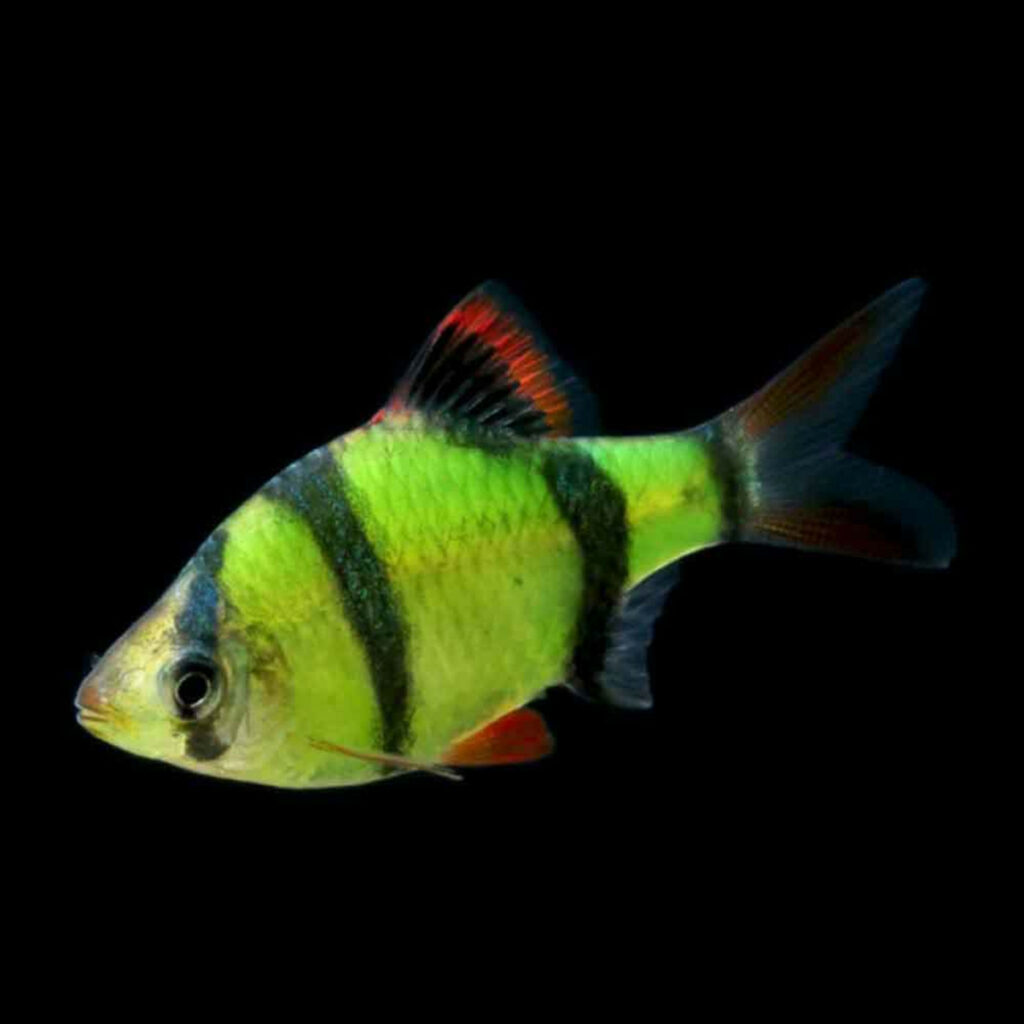
Glofish barbs are part of an evolving success story for the aquarium hobby and genetic engineering. Researchers at the University of Singapore discovered that the DNA of zebra danio embryos could be modified to express jellyfish proteins.
These proteins cause the fish to fluoresce – glow – under natural and ultraviolet light. The fish were called glofish, a name that has stuck as other species are being modified. There are now glotetras, globettas, and the glofish barb.
Globarbs are modified tiger barbs. Their care requirements are identical to their non-glowing cousins. They just come in green, pink, purple, and red now.
- Scientific Name: Puntigrus tetrazona
- Origin: Malaysia & Indonesia
- Length: 3 inches
- Temperament: Semi-aggressive
Odessa Barb
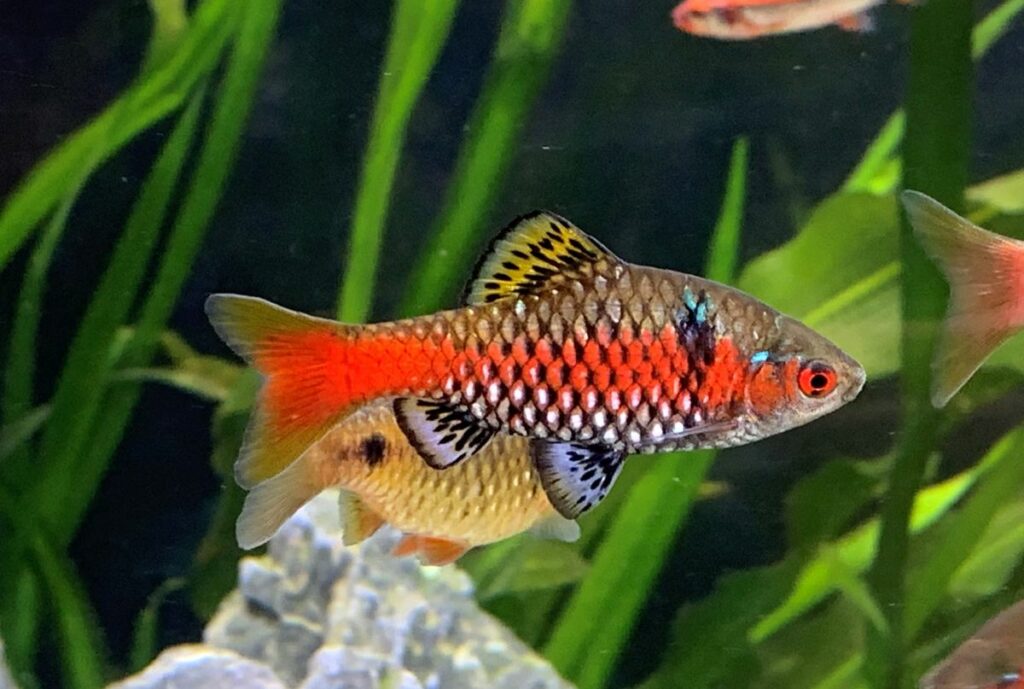
Odessa (or Ticto) barbs look like a hybrid between a cherry and a rosy barb. They are found in central Myanmar and grow to be 2 inches long at maturity. While they are peaceful barbs, sometimes they will nip at long-finned tank mates.
Some are still wild caught but they remain easy to care for as long as you avoid the extremes. Temperatures of 68-74℉ are ideal, along with a pH of 6.5 to 7.5. Wild-caught fish adapt fast to a captive diet. These omnivores eat algae, brine shrimp, flakes, and anything else offered to them.
- Scientific Name: Pethia padamya
- Origin: Central Myanmar
- Length: 2 inches
- Temperament: Peaceful
Clown Barb
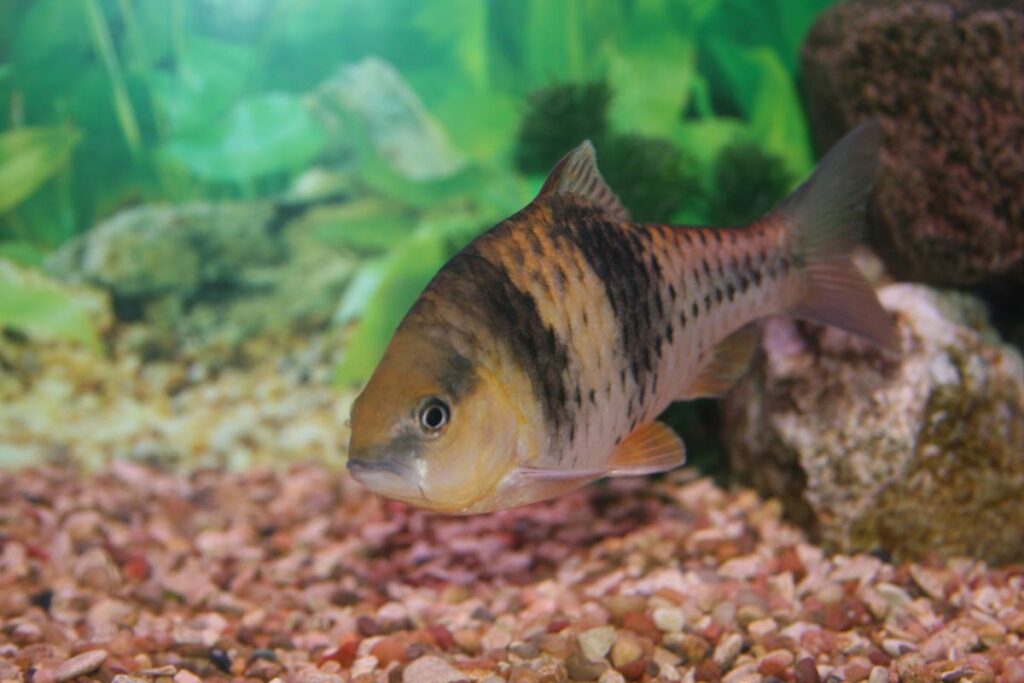
Clown barbs are not the smallest barb fish; they grow up to 6 inches long. And since they are shoaling fish, you will want a group of at least 6. They do best in tanks that are 40 gallons or more in volume.
Clown barb fish are also a little more sensitive to water quality than their relatives. Nitrogenous waste products like ammonia should be at or close to 0 parts per million. Keep them in soft, acidic water conditions. Alongside fish that enjoy the same parameters, like tetras, loaches, gouramis, and angelfish.
- Scientific Name: Barbodes everetti
- Origin: Indonesia
- Length: 6 inches
- Temperament: Peaceful
Conclusion
Barb species are diverse in size, color, and temperament. They enjoy the company of their own kind and are excellent community fish for most aquariums. Barb fish are also hardy and easy to find, making them good choices for beginning fish keepers.
FAQs
Several barbs are semi-aggressive and will nip at the fins of slow tank mates. But they prefer to chase one another around. Barbs that live alone tend to be fin nippers.
Barbs are omnivores and eat plants and animal matter. In the wild, they feed on algae, soft plants, insect larvae, fish eggs, snails, shrimp, and anything else they can find. They do well on a diet of flakes and pellets. But be sure to add variety at times; live and frozen foods add fat and color-enhancing pigments to the diet of your barb fish.
Cherry barbs are a shoaling species. They feel the most comfortable when kept in groups of 6 or more individuals. Try for an equal ratio of males and females. Otherwise the amorous males may cause the females stress if they aren’t interested.

